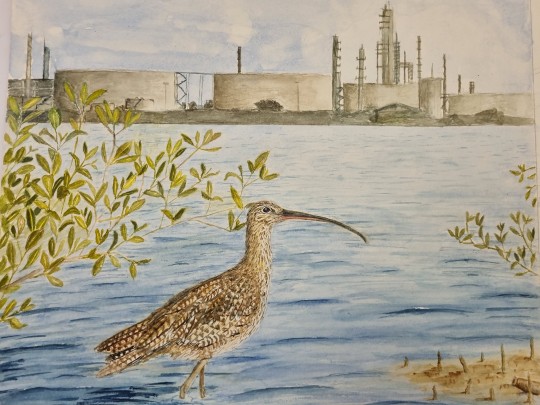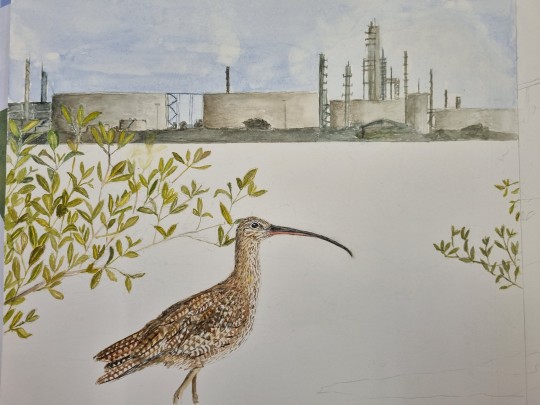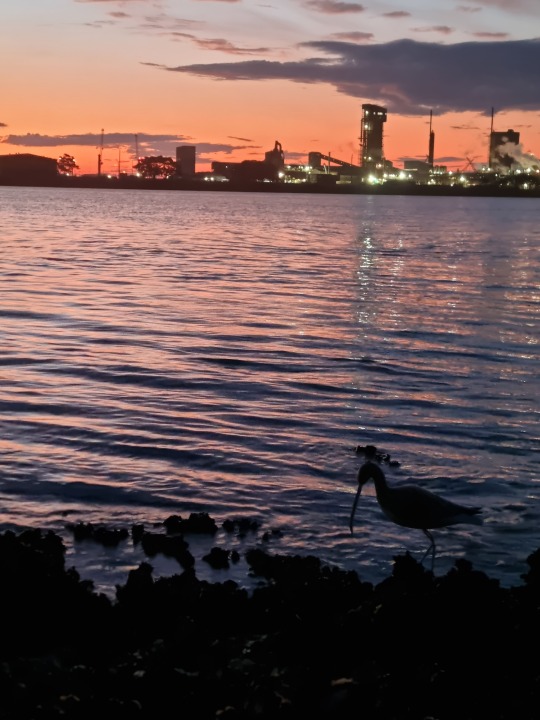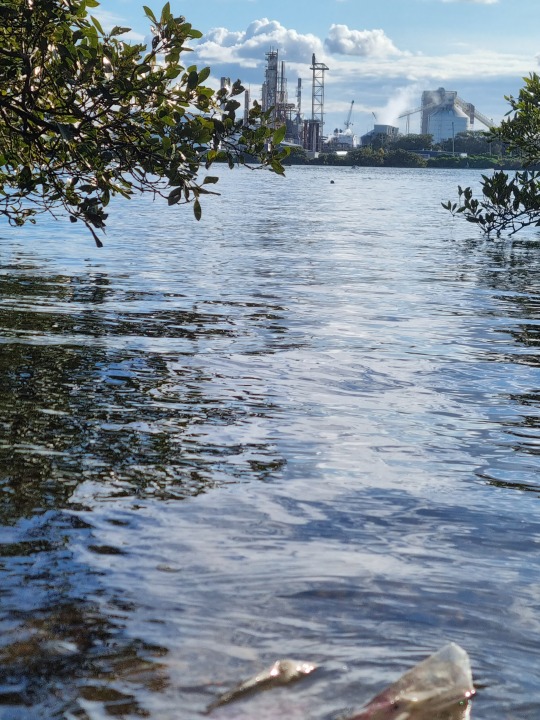Text

This week I was back in the mangrove mud photographing the unique mangrove aerial roots. These roots are like snorkels and allow the grey mangrove to grow in an anoxic environment and breath via pneumatophores in the aerial roots. They really are extremophiles, surviving in a high salt environment which would kill most plants. The grey mangrove extrude salt at root level and also have salt glands on the underside of the leaves to secrete salt. In addition, they can control the size of the stomata and can turn leaves side-on in direct sunlight to reduce water-loss. The aerial roots also act to dissipate wave energy, reduce coastal erosion and act as nurseries for fish and crustaceans (which the curlews eat). Interestingly, mangroves can also assist in heavy metal pollution by taking up and storing heavy metals (Nguyen, 2020 Int J Environ Res Public Health 17: 9131). These mangroves truly are amazing plants and well worthy of inclusion in my art-work as part of the curlew habitat, aerial roots and all!
I also found and photographed some broken bottles in amongst the mangrove roots (and then removed then and placed them in the rubbish bin). I have added the mangrove aerial roots and the broken bottle to my art-work. I also erased an error in the mangrove leaves using a specialised sponge (thanks to a special tip from my art tutor).
With the rubbish in the foreground and the industrial landscape in the background, I feel I have highlighted two big issues which are threatening the eastern curlew population with extinction. The question is: Have I overdone it? With a broken bottle in the foreground and heavy industry in the background, would you put this artwork on your living room wall? The opinion of my art group and art tutor was that I haven't overdone it, and that these elements were necessary to highlight the plight of the threatened curlew. My friends were a bit more muted, and none offered to have this artwork on their walls! So, now I am not so sure. Perhaps I have overdone it. I feel that perhaps the industrial landscape could have been a bit smaller, thus making the art-work a bit more decorative. The balance between environmental message art and decorative art is certainly hard to achieve. I will let you decide if I have been successful or not.
0 notes
Text

What colour is water and what is in the water?
This weeks challenge was to paint the water between the curlew and the industrial background. Water is a difficult subject to paint! Generally water is clear, so what are the visual cues that tell us that is is water? After a bit of research, I found the sky is the biggest influence on the colour of a body of water (Kris Parins 'what colour is water?'artistsnetwork.com/art-mediums). The sky is generally lightest at the horizon, and becoming more intense above us. It reflects in water in the same way, lightest in the distance and darkest near the viewer. The waves in the distance appear smaller, closer together and lighter than those in the foreground. Also a body of water is flat, so the horizon above the body of water needs to be level. I have tried to incorporate these elements in my artwork. The colours I chose are similar to the sky but a bit darker (as reflections tend to be a bit darker and less saturated than the actual object), so I added some indigo to darken the water colour a bit more in the foreground. Overall, I am relatively happy with the outcome of the water painting. I still need to add some white gouache highlights to add some sparkle to the water.
My next question is: how clean is this water and the sediment that the curlew is feeding in? Unfortunately Heavy metal and metalloids have been found to be elevated in the sediments of the Hunter River South Channel (where this artwork is set) and sections of Newcastle Harbour (see Lottermoser's article link inserted above). Element concentrations of Ag, As, Cd, Cr, Cu, Hg, Ni, Pb, Sb and Zn of the Hunter River sediments within heavily industrialized and urbanized Newcastle region exceeded upstream and background values by up to one order of magnitude. Sedimentary concentrations of total Lead (Pb) increased from a background of 17 ppm (upper Hunter River) to 317 ppm within Throsby Creek sediments, which then drains into the Hunter River South Arm (Lottermoser, 1998). These heavy metals can be absorbed by the curlew by eating contaminated organisms containing these heavy metals from the contaminated river mud. The adverse effects of these heavy metals on water birds include increased reproductive failure and susceptibility to bird illnesses (Pandiyan et al 2022 Toxins 10 (11) 641). Those poor curlews! They are really facing alot of problems. It is amaizing that there are any curlews left.
Next weeks challenge will be to complete the sandbar in the foreground with some mangrove aerial roots and I think I will probably add some rubbish which I frequently see stuck in the mud.
0 notes
Text

The photograph above shows the current stage of my artwork. Painting the mangrove leaves was alot harder than anticipated. As the mangrove is reasonably close to the foreground, it was not possible to use a loose watercolour style, and it required painting the individual leaves. Gaining a 3D feel and depth to the mangrove bush was difficult and I have not managed to achieve this so far. I plan to add some darker leaves in the background to try to improve this.
I have also decided to crop the artwork, as painting the large mangrove I initially planned on the right side of the artwork would be too time consuming. So now the mangrove on the right of the image is mostly blocked out and only the peripheral branches are in the actual artwork. Also it was hard to maintain a random shape for the mangrove. It is very easy to make it look to regular and symmetrical, which is un-natural. I decided to wash back one of the upper branches to improve the shape of the mangrove bush, and I will insert a distant navigation buoy there instead.
To try to take my mind off the problems with the mangroves for a bit, I launched into painting the industrial background. Here I could use symmetry and straight lines, and actually quite enjoyed this part of the painting. I chose to use a limited colour pallet, which I think has worked well and has not made the industrial background too overpowering. I used a light cobalt watercolour wash for the sky and dabbed out the steam and smoke from the industrial plant with a damp sponge. Again, I was quite happy with the appearance of the sky in my artwork.
I started to wonder what is in those huge tanks that I was painting? It turns out they are the ammonia and ammonium nitrate storage tanks belonging to the Orica chemical plant (the same chemicals that exploded in Beirut in 2020, killing 218 people). Ammonium nitrate is manufactured through the reaction of ammonia and nitric acid. Ammonia production is responsible for roughly 2% of fossil fuel use worldwide, and releases more than 400 million tons of CO2, representing more than 1% of total annual global emission of this greenhouse gas (pnas.org>doi>pnas.2119584118). In addition, there was a chromium spill in 2011, and several air and water pollution breaches from this Orica chemical plant in 2014.These greenhouse gas emissions, in addition to the potential for further air and water pollution episodes create additional threats to the already endangered Eastern Curlew.
Next weeks task is to tackle the water landscape separating my curlew from the industrial background.
0 notes
Text

Curlews Mangrove Habitat under threat
This week I am working on the mid-ground of my painting depicting two grey mangroves (Avicenna marina). I am using my photograph (inserted above) for the mangrove on the left side my painting. I have been studying the the leaf colouration (best made by mixing ultramarine blue and cadmium yellow), and branching pattern to ensure it is recognisable as a grey mangrove. The under-surface of the leaf is an amazing olive grey colour (hence the name grey mangrove).
While doing my field practice drawings and colour swatches in the smelly mangrove mud, I noticed that there was quite alot of die-back and poor leaf health on some of the mangroves in the river opposite Kooragang Island industrial estate.
I did a bit of research and found that mangroves are essential for reducing coastal estuary erosion, are important fish and prawn hatcheries and are important habitat for shore birds such as the Eastern Curlew. Mangroves store far more carbon than terrestrial forests. Infact, Mangrove can sequester 4X more carbon than rainforest can! Most of this carbon is stored in the soil beneath the mangrove trees rather than on the surface as terrestrial trees do, thus holding the carbon better and longer. (https://news.mongabbay.com/2018/05/new-study-finds-mangroves-may-store-way-more-carbon-than-we-thought/).
But unfortunately mangroves are very susceptible to pollution and high nutrient levels from sewerage and intensive farming. Following flooding events, the mangrove aerial roots can get buried in mud suffocating the mangrove trees (see article above). Also prolonged high day-night temperatures in February kills early mangrove flowers , stopping flowers from setting seed (dcceew.gov.au/wetlands/publications). So I am saddened that once again we seem to be upsetting the natural balance of the coastal wetlands habitat in a bad way, not just for the curlews but also for the mangroves.
Now I am busy painting the mangroves leaf by leaf and it is slow going. I will show you the results of my labours next week.
0 notes
Text

Painting Shy Masters of Camouflage
My painting is finally underway (see progress photo above).
The curlews are masters of camouflage, blending in very well to their coastal grasses and mudflats habitat. In addition, they are shy birds, often taking flight when a person or agitator is up to 250 metres away. This creates two problems. First people often don't notice the presence or absence of the curlews, and thus are often unaware of their markedly decreasing population. The second is a more personal problem, in that it is quite difficult to get good detailed photographs of the Eastern Curlew because it is difficult to get near them to photograph them in enough detail to see the intricacies of their complex plumage.
I finally managed to get some reasonable photographs of the curlews. The next problem was to accurately paint a master of camouflage which has complex mottled-brown plumage!
The first stage was to get good detail of the bird's eye, as this is a very important element of any bird painting. I was glad I chose to only paint one curlew, and I hope I have been able to capture this bird so that it is looking up at the viewer almost pleading for help to save it. It was also important to capture the large size and and down curved shape of the beak, which is a key identification feature of the Eastern Curlew.
The next challenge was to capture the brown mottled feather detail. I managed to collect a curlew feather to get the colour and shape of the markings. Then it was just slow careful painting to capture the mottled plumage effect. In the end, after many hours of work, I was reasonably happy with my curlew painting.
The next challenge will be to set the curlew image amongst mangroves in the mid-ground of the painting, and have the industrial landscape as the background. Next weeks goal will be to paint the mangroves.
0 notes
Text

Are Industrial estates good or bad for the eastern Curlew?
Yesterday while doing some further photography for my artwork (see photo above), I did another Eastern Curlew count on the beach and mudflats adjacent to the Kooragang Industrial estate. There were no curlews on the beach where people were walking their dogs, but I counted 29 Eastern Curlews roosting near the Kooragang industrial estate mudflats. I was pleased that more curlews have now arrived (my first count a few weeks ago was only 5 curlews).
I read two interesting research papers this week. The first by Madeline Stigner found that the presence of dogs and people on the foreshore near Morton Bay QLD significantly increased the probability of shorebirds not occupying an area, with the presence of dogs having twice the effect of people. The effect increased further as the dog numbers increased. The second paper by Lilleyman et al published in the Northern Territory Naturalist (2018) 28:30-42 studied the distribution of migratory shore birds in Darwin Harbour. Safe roosting sites are critically important for shore birds like the Eastern Curlew that feed on coastal inter-tidal zones that become inundated by the high tide twice a day. Lilleyman (2018) found that significantly increasing numbers of Eastern Curlew are roosting at artificial sites such as East Arm Wharf because human and dog access to the site is restricted. The Eastern Curlew is extremely wary and will take flight at the first sign of danger, long before other nearby shorebirds become nervous.
So in my artwork, I will be using the Kooragang industrial estate as a background thinking this was all bad because industrial development on coastal and estuary foreshore is using up valuable curlew habitat. But it looks like it may also be providing the curlews with some protection from humans and dogs, as people are less likely to walk their dogs along muddy shores next to an industrial estate.
I have completed my 4 'thumb-nail' composition sketches and obtained feedback from my art group and my friends. The clear winner was the image with a single curlew standing in shallow water in the foreground near some mangroves with some rubbish floating in the water, and the Kooragang industrial landscape as the background. Runner up was a thumb-nail sketch based on the above photograph of a curlew in silhouette in foreground and sunset on the industrial background. The lack of any detail in the silhouette bird image was a problem with this image as it would not allow proper identification of the bird species. I also sketched out multiple curlews in the foreground, but decided a single curlew worked better as the bird numbers are low and declining by 6% per year. My fourth image was of a curlew flying and trying to land amongst some rubbish on the fore-shore. My problem with this image was that my photographs of curlews flying are poor and have insufficient detail to use in my painting.
I have sketched out my preferred image on A3 300GSM hot pressed watercolour paper and I am now painting the curlew in the foreground.
0 notes
Text

Is Rubbish Art?
This week I have been experimenting with industrial backgrounds and image composition. Above is one of my photographs for possible use in my artwork. I am thinking I could paint this or a similar image as the background and paint an Eastern Curlew standing in the foreground amongst the floating rubbish in the foreground. This would highlight two of the issues threatening the Curlew with extinction. 1. Habitat loss through industrial foreshore development and 2. Pollution of the waterways and feeding areas of the Curlews.
Although the foreground may look like a partially submerged rock, it is actually a plastic bag (an empty bait bag which just happened to float past at that moment, which I then pulled out of the water with a stick and disposed of in the bin after I had taken the photograph). If left in the water, over time this plastic bag will break into small pieces and could be ingested by the curlews and shorten their lifespan and affect their reproductive capacity. It takes about 450 years for plastic products to biodegrade. So even a simple plastic bag in the water may cause problems for a long time!
This then asks the question: Is Rubbish Art? According to Quora.com, an artist might take rubbish and use it as a symbol of certain meaningful aspects of a thing, and then display that trash (or anything else) as art. In the June 2018 edition of National Geographic, the front cover image is of a plastic bag floating in the ocean and photographed to look like an iceberg, with the title 'planet or plastic?' It is a very powerful image with a certain beauty, even though it is a plastic bag. So I hope to use my floating plastic bag in the foreground of my artwork and try to make it look attractive, but still retain its powerful message about the curlew's plight and the poor state of the environment.
I have sketched out 4 'thumb nail' sketches of possible artwork composition (two landscape and two portrait composition). I will obtain feedback on these images in next weeks art group, and then begin drawing out the actual artwork.
0 notes
Text
Curlews in Trouble
This is my first blog ever. I hope it works!
I am doing a project to create an artwork depicting the critically endangered Eastern Curlew which is decorative, but also highlights issues threatening the Curlew Population.
The Eastern Curlew is Australia's largest shorebird and the world's largest sandpiper standing 60cm tall, 66cm long, 110 cm across the wings and weigh a whopping 1.2kg. They have brown streaked plumage, and a very long down curved beak for digging for crabs, prawns and molluscs in the mud along coastal estuaries (their beaks are the same length as their bodies!) They migrate from Australia to Russia each year via the Yellow Sea Mud flats. Can you imagine something that weighs the same as a bag of sugar with a one meter wingspan flying all the way from Australia to Russia without buying a Quantas air ticket? Because of their size and weight, they need to stop off half way on their migration to refuel in the yellow sea mudflats. These mudflats have unfortunately been dredged and filled in with Chinese and Korean industrial development.
The global population of the Eastern Curlew has declined 80% in the last 30 years due to pollution, Industrial and urban development. The curlews are in the top 10 of endangered animals in Australia at risk of extinction according to Nature Conservancy Australia.
Most artwork depicting the Eastern Curlew is purely decorative or for scientific identification purposes, and does not address the major problems facing the Eastern Curlew population. So my challenge is to create an art work depicting the Eastern Curlew which is decorative, but also highlights the issues and difficulties facing the Curlew population.
This weeks task was to do my field research and photography, which I have achieved and enjoyed. First, I visited the Stockton Sandspit on east coast NSW to photograph the curlews returning to Australia after their trip to Russia to breed. I was delighted to see that 5 curlews had returned. This number is markedly reduced from previous years, but I am ever hopeful that maybe they are a bit late coming back to Australia this year, and that more are on the way.
Eastern Curlews are a very shy bird and notoriously difficult to photograph because they always keep their distance from you. I used my 500mm lens and obtained some photographs of the curlews. They are all quite thin after their epic flight back to Australia. I also tried doing some field sketches through my bird telescope. I am not to sure how useful they will be yet.
To depict the problems facing the rapidly declining curlew population, I plan to place the birds in an industrial landscape. I plan to use the Industrial background of Kooragang Island in my art work. So I walked along the Hunter River foreshore and photographed the Kooragang industrial landscape on the other side of the river at different times of the day and in different light conditions. My aim is to use this industrial background to highlight the birds problems, but try to depict it in an artistic way so that people may still buy the artwork images and be happy to place them on the walls of their houses and offices.
1 note
·
View note